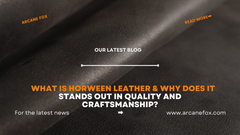How Is Leather Dyed? Inside the Art, Science, and Craft of Color

How Is Leather Dyed? Inside the Art, Science, and Craft of Color
Leather dyeing blends creativity with chemistry, turning plain hides into rich tones full of life. Each piece of vegetable-tanned or full-grain leather carries color that reflects skill and patience. Understanding how leather is dyed helps you see the craftsmanship behind every jacket, bag, or boot you own.
From choosing the right dye type to applying the perfect finish, every step shapes the final result. This guide takes you through the leather dyeing process, covering traditional techniques, sustainable dye methods, and expert insights that reveal how color transforms leather into something timeless.
Key Takeaways
- Leather dyeing is a detailed craft that blends creativity, science, and precision to achieve lasting, vibrant results.
- Each leather type and dye formula affects how color bonds, absorbs, and appears over time.
- Proper preparation, controlled application, and patient drying are essential for achieving professional-quality finishes.
- Sustainable dyeing practices and eco-friendly materials are defining the future of ethical leather craftsmanship.
1. Types of Leather and Their Impact on Dyeing

-
Full Grain Leather: Natural texture defines full-grain leather, allowing color to sink deep into every pore. When alcohol-based or oil-based dyes are applied, they highlight the grain beautifully, giving a rich, lasting finish. The deep-dye penetration preserves the leather's natural character while enhancing its depth and vibrancy.
-
Top Grain Leather: Sanded for smoothness, top-grain leather accepts color evenly, producing a clean, polished look. When water-based leather dyes or oil-based formulas are used, the result is refined and consistent. Its even absorption makes it ideal for creating luxury goods with sleek tones and a flawless surface.
-
Vegetable Tanned Leather: With its natural fibers, vegetable-tanned leather pairs perfectly with plant-based and natural leather dyes. Though the dyeing process takes more time, it rewards you with warm, earthy shades that age gracefully. This type of leather also offers impressive color fastness, blending sustainability with timeless style.
-
Chrome Tanned Leather: Modern techniques make chrome-tanned leather quick to color and easy to style. Synthetic and pigment dyes work efficiently on their surface, producing bold, bright tones. When finished with water-based dyeing solutions, it gains vibrant shades and smooth consistency, perfect for contemporary leather accessories and apparel.
1.1 Why Leather Type Matters
Each leather type reacts differently to dye, changing how color settles and lasts. Full-grain leather soaks in dye deeply, giving a natural, textured finish, while chrome-tanned leather absorbs it more quickly, creating brighter, smoother tones. These differences define the final look and durability.
Picking between vegetable-tanned and chrome-tanned leather shapes the result you want. Vegetable-tanned leather gives a timeless, earthy tone, while chrome-tanned leather offers vibrant shades suited for fashion pieces.
Understanding how leather is dyed begins with knowing your material. The right leather ensures even coloring, better texture, and a finish that enhances both beauty and strength.
2. Leather Dye Types and Technologies

Leather dyeing relies on the right technique and formula to achieve lasting color. Each dye type adds its own character, depth, and texture to the final finish.
- Water-Based Leather Dye: Offers breathable color and a natural finish. Good for softer tones and eco-conscious consumers.
- Oil-Based Leather Dye: Creates deep, vibrant tones that penetrate well. Perfect for full-grain leather and long-lasting results.
- Alcohol Based Leather Dye: Dries quickly and suits detailed work. Used for bold tones and precision work by many artisans
- Pigment Dye versus Aniline Dye: Pigment dye coats the surface for a solid color. Aniline dye penetrates leather fibers for a natural visible grain.
- Drum Dyeing versus Spray Dyeing: Drum dyeing colors leather completely inside tanning drums. Spray dyeing colors the surface for consistent coverage and artistic finishes.
From rich drum-dyed tones to sleek spray finishes, every method shapes leather’s identity. The right dye brings both beauty and durability to life.
3. Detailed Step-by-Step Leather Dyeing Process
Leather dyeing is a precise blend of art and science. Each stage, from cleaning to finishing, determines how color bonds and endures. Proper techniques ensure even absorption, long-lasting vibrancy, and a professional finish that highlights the material’s natural beauty and strength.
Step 1: Prepare the Leather

Wear Gloves
It seems obvious, but skipping gloves is a mistake you’ll regret. Every time I thought, “I’ll be careful,” I ended up with stained hands. Save yourself the trouble, wear gloves.
Ensure Proper Ventilation
While not deadly, oil dye fumes are unhealthy to breathe for long periods. Open a window or set up a fan to keep air flowing. Even a simple setup works fine.
Pick the Right Leather
You can dye any undyed vegetable-tanned leather. Technically, you can dye pre-dyed leather, too, but the waxes on finished surfaces prevent good absorption. Using 100% top-grain leather means you’ll see natural marks and shades; it’s high quality but shows imperfections. If your leather has inconsistencies, they’ll appear even with perfect dyeing. Industrial processes use full immersion for a smoother finish, but hand dyeing highlights the leather’s character.
Clean the Leather
Dust and residue collect fast, especially if you’ve been sanding. Wipe the leather with a dry cloth before dyeing. Some prefer a deglazer to remove oils from handling; Fiebings makes a good one.
Dilute Your Dyes
For oil-based dye, Fiebings Pro Dye works well. For water-based, try Tandy’s Eco-Flo. Both deliver even results. Always dilute, use Fiebings dye reducer for oil or plain water for water-based. Multiple coats look smoother than one heavy layer. One thick coat locks in color unevenly and can create a marbled look. Also, water-based dyes dry out leather, so apply Neatsfoot Oil afterward to restore moisture. Now, onto dyeing.
Step 2: Apply the Base Coat in Circular Motions

This first coat is key. Dip a cloth or sponge into dye, then rub it in circular motions until fully covered. Let it dry.
A few lessons learned:
- Don’t press too hard at first. The initial contact releases more dye, so start lightly, then add pressure as the cloth dries out.
- Reapply dye when the coverage looks spotty.
- Overlap circles by about half for even coverage.
- Dye past the edges, don’t stop right at the border, or you’ll get pale outlines.
Step 3: Add a Second Coat Diagonally to the Right

After the base coat dries, apply the second layer in smooth diagonal strokes from top left to bottom right. Overlap slightly for even color. Keep pressure light and avoid oversaturation. This coat deepens tone and improves coverage. Let it dry naturally before moving to the next step.
Step 4: Add a Third Coat Diagonally to the Left

Once dry, apply another coat diagonally from top right to bottom left. This cross-pattern ensures full grain coverage and eliminates streaks. Use light, consistent strokes and avoid pressing too hard. Allow it to dry completely for a balanced, rich color finish.
Step 5: Apply Finish and Buff

Once the last coat dries, seal it with a finish; skipping this step will cause the dye to rub off on clothes. Use Fiebings Tan Kote (matte or gloss). Apply one even coat in circular motions. Let it dry completely before touching, or you’ll ruin the finish. When dry, buff it with a soft cotton cloth.
Now your project should have a rich, even color and smooth texture. If not, don’t worry, consistent practice makes a flawless finish possible. And no, this isn’t a sponsored pitch for Fiebings, I just genuinely like their products.
4. Key Technical Variables and Challenges
Achieving flawless leather dyeing requires precision and control. Small technical variations can completely change the final result. Understanding these factors ensures consistent, high-quality color every time.
- pH levels determine how well the dye binds to leather fibers.
- Temperature affects absorption speed and the depth of color.
- Surface texture and finish influence how quickly dye penetrates.
- Consistent color and streak-free results demand patience and steady technique.
- Improper preparation or dilution often leads to uneven tones or fading.
In short, mastering these variables separates expert craftsmanship from average dye work and ensures long-lasting, vibrant leather.
5. Sustainability and Future Trends in Leather Dyeing

Leather dyeing is evolving with a strong focus on sustainability. Traditional chemical dyes are being replaced by eco-friendly alternatives that reduce harm to the environment. Plant-based dyes made from roots, bark, and fruits create natural tones while maintaining the richness of color and texture that high-quality leather demands.
Waterless dyeing systems are another major innovation. By using minimal water and closed-loop processes, modern tanneries reduce pollution and resource waste. These methods also improve dye consistency and shorten production time.
Today, sustainable leather dyeing defines the direction of ethical fashion. Tanneries adopting cleaner technology and waste treatment systems set new standards for responsible production, blending environmental awareness with the timeless artistry of leather craftsmanship.
6. Industry vs DIY: What Professionals Do vs What You Can Try at Home
Professional tanneries rely on precision and scale. They use drum dyeing machines, automated finishing systems, and temperature-controlled drying rooms to ensure deep color penetration and consistent texture. Every step follows strict quality standards, producing leather that is durable, even-toned, and ready for large-scale use.
DIY leather dyeing, in contrast, focuses on creativity and hands-on care. It involves simple tools such as brushes, sponges, or spray bottles, and relies on air drying. While results may vary, it allows for experimentation and a personal touch.
Both approaches share one goal: beautifully dyed leather. With patience and practice, DIY enthusiasts can achieve impressive results, while professionals continue to refine the craft through technology and expertise.
7. Common Mistakes in Leather Dyeing and How to Avoid Them

Even small errors can ruin the beauty of dyed leather. Awareness of these mistakes helps you achieve a flawless finish that lasts longer and looks professional.
- Skipping surface cleaning leads to uneven absorption and patchy color. Always clean and deglaze before applying dye.
- Choosing the wrong dye type causes dull finishes or peeling. Match dye type with your leather’s texture and treatment.
- Applying too much dye leaves streaks or dark blotches. Work in light layers for a smooth tone.
- Rushing drying time weakens color bonding and causes cracks. Let the leather air dry completely.
- Ignoring protective sealers shortens durability. Seal the surface to preserve shine and prevent fading.
Patience, preparation, and precision turn dyeing from a risky task into a lasting work of craftsmanship.
8. How to Care for Dyed Leather and Extend Color Life
- Use a gentle cleaner and avoid harsh chemicals.
- Apply leather conditioner to maintain softness and shine.
- Keep leather away from the sun, moisture, and heat.
- Use protective sprays to help color stay vibrant.
- Reapply conditioning periodically to prevent fading or drying.
9. Conclusion
Leather dyeing is a careful balance of skill, chemistry, and patience. From selecting the right leather type to applying the perfect dye, every step shapes its color, texture, and longevity. Whether done by professionals using drum systems or by hobbyists at home, the process transforms raw hides into timeless, vibrant pieces.
Today’s leather dyeing also embraces sustainability through plant-based dyes and waterless methods, blending tradition with innovation. Understanding how leather is dyed helps you appreciate the craftsmanship behind every product and recognize true quality in color and finish.




